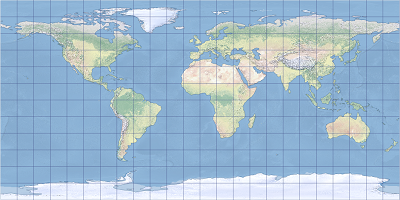Description
The plate carrée map projection is an equidistant cylindrical projection with the standard parallel located at the equator. A grid of parallels and meridians forms perfect squares from east to west and from pole to pole. It is one of the simplest and oldest map projections, and therefore its usage was more common in the past. The radius is used as a conversion factor between angular and linear units. Another usage of this projection is to display spatial data stored in a geographic coordinate system, known as the pseudo-plate carrée projection.
The projection was invented by Marinus of Tyre around A.D. 100. It is available in ArcGIS Pro 1.0 and later and in ArcGIS Desktop 8.0 and later.

Projection properties
The subsections below describe the plate carrée projection properties.
Graticule
Plate carrée is a cylindric projection. The meridians and parallels are equally spaced straight lines forming a Cartesian grid of perfect squares. In this projection, the poles are represented as straight lines across the top and bottom of the grid, the same length as equator. The graticule is symmetric across the equator and the central meridian.
Distortion
The plate carrée projection is equidistant along any meridian and the equator. Shape, scale, and area distortion increase with the distance from the equator. North, south, east, and west directions are always accurate, but general directions are distorted, except locally along the equator. Distortion values are symmetric across the equator and the central meridian.
Usage
This projection can be used for simple portrayals of the world or regions with minimal geographic data and those not requiring accurate areas. This makes the projection useful for index maps and to map phenomena that change with longitude, for example, time zones. Most often, data in a geographic coordinate system is displayed in a pseudo-plate carrée projection in which the decimal degree values are treated as if they are linear.
Limitations
Supported on spheres only. For an ellipsoid, the semimajor axis is used for the radius.
Parameters
Plate carrée parameters are as follows:
- False Easting
- False Northing
- Central Meridian
Sources
Snyder, J. P. (1987). Map Projections: A Working Manual. U.S. Geological Survey Professional Paper 1395. Washington, DC: United States Government Printing Office.
Snyder, J. P. (1993). Flattening the Earth. Two Thousand Years of Map Projections. Chicago and London: University of Chicago Press.
Snyder, J. P. and Voxland, P. M. (1989). An Album of Map Projections. U.S. Geological Survey Professional Paper 1453.Washington, DC: United States Government Printing Office.